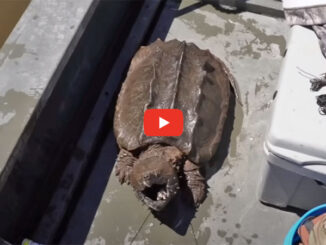
Surprise catch happened Tuesday evening in The Cove at Cypremort Point
When there’s a big fall bite going on in The Cove, Cypremort Point anglers know that typically means speckled trout have finally moved in adjacent to camps and piers in an easily accessible spot on the east shore of Vermilion Bay.
Word spreads quickly, and an armada of boats and anglers soon move in to battle specks in what’s a fall tradition for the area.
But Pat Hammon got a totally different “big bite” Tuesday afternoon in The Cove — one that’s he’s never experienced in 40 years of fishing around Vermilion Bay.
When his 4 Horseman cork vanished about 5:30 p.m., the 59-year-old St. Martinville angler was initially thinking a redfish or speckled trout had devoured his offering of a tasty live shrimp.
Then he picked up the rod — and immediately changed his mind.
“We had just went to the dam (on Marsh Island) and caught a bunch of live bait and tried a couple of spots at Dry Reef, but we didn’t do much, so I said, ‘Let’s go try The Cove,’” Hammon said. “We have a couple of honey holes in there, so the first spot we stopped at we started catching some fish.
“I was netting a redfish for my buddy and I had put my rod in the rod holder, and I looked and the rod was bent.”
When he grabbed the rod, Hammon instantly knew something was amiss, and said the weight he felt was tremendous.
“It didn’t pull drag. I didn’t know what I had. It was like a big wet beach towel, like pulling in a 5-gallon bucket,” he said with a chuckle. “I said, ‘What the hell I got right here? A body?’”
Actually, what he had was a big loggerhead sea turtle — one that Hammon estimated weighed at least 60 pounds, with a 3-foot-long barnacle-covered shell.
Mandy Tumlin, a biologist with the Louisiana Department of Wildlife and Fisheries who serves as the marine mammal and sea turtle stranding and rescue program coordinator for the state, saw Hammon’s picture and identified the turtle as a loggerhead, but couldn’t tell the sex of the animal or get a good age estimate based on the photo.
“Loggerheads get to be about 3 feet long on average, and can weigh up to 250 pounds once they’re adults,” Tumlin said. “It looks like this would be a sub-adult to an adult, but it’s just so hard to say. But dinner plate-size is around 2 to 5 years, so it’s an older animal, yes.”
Loggerheads, which are officially classified as threatened, live in open ocean and nearshore coastal waters, so Tumlin said it’s likely not a fluke the turtle was in the area, and noted that females’ nesting season is April through September, with the peak in June and July.
“They’re often entering marshes, estuaries and coastal rivers, and loggerheads are pretty common in the Gulf,” she said. “They’ll nest on certain beaches, and they’ll use the foraging grounds along the coast of Louisiana, and move in between nesting grounds and foraging grounds.”
All sea turtles are federally protected under the Endangered Species Act, and Tumlin said Hammon and his crew did exactly what she would have hoped: safely remove the hook, take a photo for species identification and then let the animal go unharmed.
She cautioned, however, to be careful when removing the hook.
“Loggerheads have powerful jaws that are used for crushing their prey, so these turtles will bite, so people need to be cautious putting their hands near its mouth,” she said.
If a sea turtle is gut-hooked, Tumlin said to cut the line about 3 feet from the hook, hold on to the turtle and immediately contact her office so that arrangements can be made to collect the animal and bring it to a rehabilitation center.
Tumlin, who can be reached day or night at 337-962-7092 or at the LDWF office at 225-765-2377, also encouraged anglers also to be aware of any external metal flipper tags on a turtle’s front flippers. If a turtle has been tagged, make note of that number before releasing it so researchers can document and track that particular animal.
She also asked that even anglers who catch and release a turtle contact her office with the location, a photo and details on the catch — noting that no one would get in trouble for incidentally catching a sea turtle on a rod and reel.
“We can’t be everywhere all the time, so we rely on the eyes and ears of the public out on the water and out on the beaches, helping us know where strandings are and where live animals are, so we can all work together to protect these for future generations,” she said.
Hammon said unhooking the beast actually proved surprisingly easy.
“I grabbed it by the back flippers and slid it up the side of my boat. When you get it out of the water, it’s pretty much helpless. I guess it’s so heavy, it depends on the buoyancy of the water to move,” he said, noting it was hooked right in the corner of the mouth with a 1/0 kahle hook. “After I got it on the side of my boat, there was no resistance. It didn’t buck, it didn’t fight — maybe it was stressed or exhausted.”
Fortunately, the big reptile seemed no worse for the wear — and Hammon said it didn’t linger around long after regaining its freedom.
“When we got the hook out and put it back, that thing took off,” he said with a laugh. “He booked — those flippers were turning up some RPMs and he was getting the hell out of there.”
